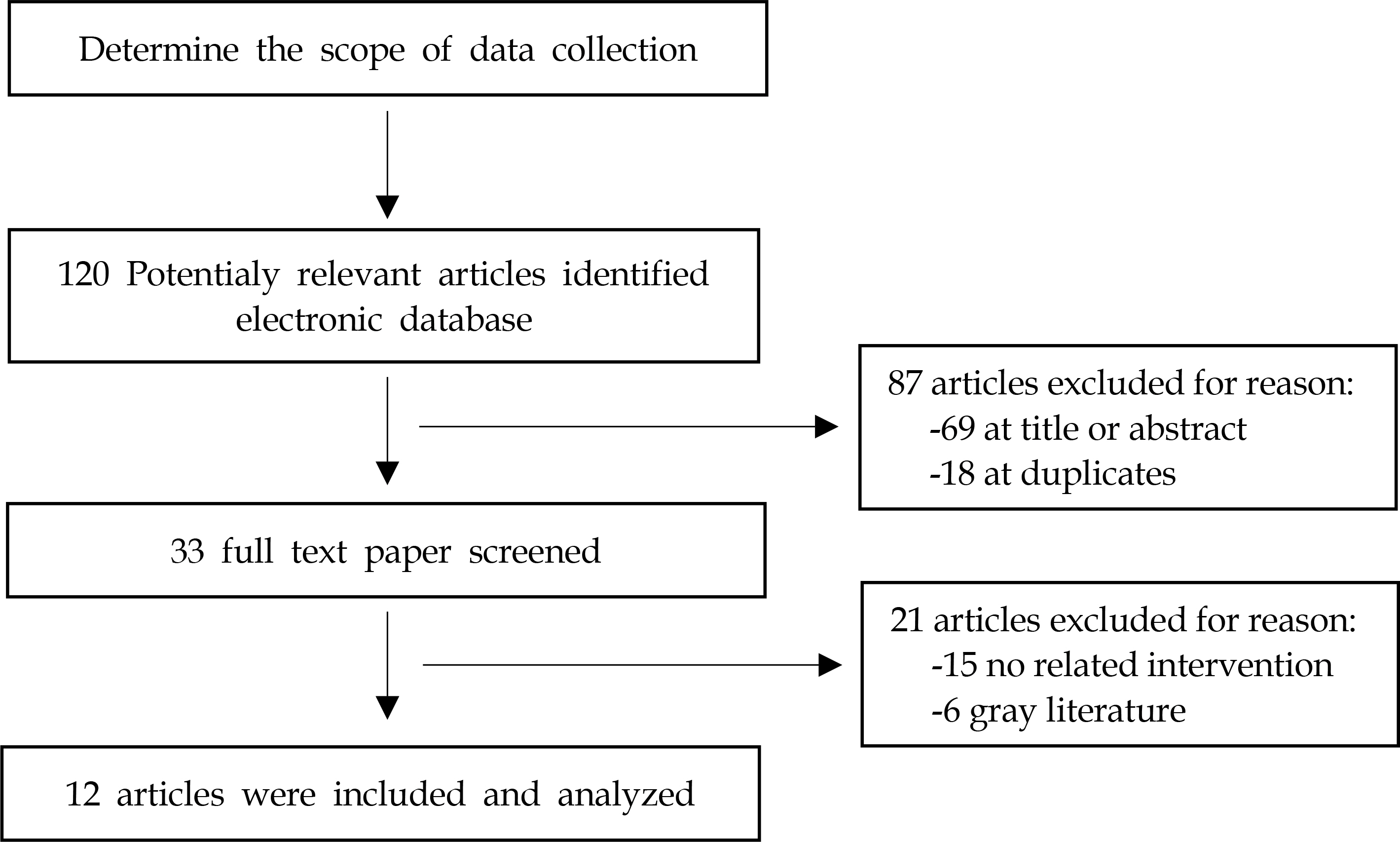Perspect Nurs Sci.
2016 Apr;13(1):36-47. 10.16952/pns.2016.13.1.36.
Integrative Review of Nonviolent Communication Intervention Studies
- Affiliations
-
- 1Department of Nursing, Korean Bible University, Seoul, Korea.
- 2College of Nursing · The Research Institute of Nursing Science, Seoul National University, Seoul, Korea. sungjae@snu.ac.kr
- KMID: 2315723
- DOI: http://doi.org/10.16952/pns.2016.13.1.36
Abstract
- PURPOSE
This study aimed to uncover the evidence for developing effective communication intervention programs by analyzing and evaluating Communication Intervention Studies using Nonviolent Communication (NVC-CI). The specific purposes were to analyze general characteristics of NVC-CI studies, intervention contents, and the effectiveness of the studies.
METHODS
This was an integrative review that analyzed NVC-CI studies published from 2005 to 2015 identified through searches of five Korean electronic databases. The method proposed by Whittemore and Knafl was applied. This contains four stages: problem identification, literature search, data evaluation, and data analysis.
RESULTS
Twelve studies met the inclusion criteria. Most of the experimental designs were Quasi-experimental studies. These included 9 papers (75%), one qualitative study, one mixed methodology, and one case study (8.3% respectively). Most NVC-CI studies used group intervention. In order to effectively change communication patterns, interventions needed about 10~11 sessions 1~2 times a week.
CONCLUSION
Future research with well-designed clinical trials using NVC-CI needs to be done in the area of mental health nursing to promote communication skills.
Keyword
Figure
Reference
-
1.Arnold EC., Boggs KU. Interpersonal relationships: professional communication skills for nurses. 5th ed.Missouri: Saunders Elsevier;2007.2.Marlow E., Nyamathi A., Grajeda WT., Bailey N., Weber A., Younger J. Nonviolent communication training and empathy in male parolees. J Correct Health Care. 2012. 18(1):8–19. http://dx.doi.org/10.1177/1078345811420979.
Article3.Lee YO., Cheon SM., Ryu WJ., Jeong HG. The effect of classroom-based nonviolent communication training program on middle school student's communication and peer relationships. Korean J East West Sci. 2009. 12(2):45–57.4.Naranjo C., Kornreich C., Campanella S., Noel X., Vandriette Y., Gillain B, et al. Major depression is associated with impaired processing of emotion in music as well as in facial and vocal stimuli. J Affect Disord. 2011. 128(3):243–51. http://dx.doi.org/10.1016/j.jad.2010.06.039.
Article5.Kelly JF., Stout RL., Tonigan JS., Magill M., Pagano ME. Negative affect, relapse, and Alcoholics Anonymous (AA): does AA work by reducing anger? J Stud Alcohol Drugs. 2010. 71(3):434–44. http://dx.doi.org/10.15288/jsad.2010.71.434.
Article6.Marlatt GA. Taxonomy of high risk situations for alcohol relapse: evolution and development of a cognitive-behavioral model. Addict. 1996. 91(12s1):37–50. http://dx.doi.org/10.1046/j.1360-0443.91.12s1.15.x.7.Kim HY., Kwak IS., Hong SH., Kim SH. The development of a life coaching educational program at the healthy family support center. Korean Home Manag Assoc. 2009. 27(4):19–30.8.Kornreich C., Foisy M-L., Philippot P., Dan B., Tecco J., Noel X, et al. Impaired emotional facial expression recognition in alcoholics, opiate dependence subjects, methadone maintained subjects and mixed alcohol-opiate antecedents subjects compared with normal controls. Psychiatr Res. 2003. 119(3):251–60. http://dx.doi.org/10.1016/S0165-1781(03)00130-6.
Article9.Rosenberg MB. Nonviolent communication: a language of life. 1st ed.Han K, translator. Seoul: Korean Center for NVC;2013.10.Krnvc.org [Internet]. Seoul: Korean Center for Nonviolent Communication; [updated 2013]. Available from:. https://www.krnvc.org:5009/.11.Kim YW., Kim YG. Study on traditional medical healing method of hwa-byung examined with 4 compositional elements of nonviolent communication (NVC). J Korean Cult. 2015. 29:217–40.12.Whittemore R., Knafl K. The integrative review: updated methodology. J Adv Nurs. 2005. 52(5):546–53. http://dx.doi.org/10.1111/j.1365-2648.2005.03621.x.
Article13.Cheung KG., Choi HN. The effectiveness of an intensive nonviolent communication group counseling program on employees' interpersonal competence, interpersonal stress, and job satisfaction. J Hum Underst Couns. 2011. 32(1):31–46.14.Lee MG., Kwon HY. A study for the effect of strengthening family program on high school student's communication and conflict solving style. Korean J East West Sci. 2014. 17(1):127–52.15.Lee HJ., Kim SO. The development and verification of an experiential couple group therapy program-integration of the Satir growth model and non-violent communication. Korean J Couns. 2010. 11(2):831–54.16.Chang JK., Jun JM., Lee JW. A study on the effectiveness of couple group counseling program for improving marital satisfaction. Fam Cult. 2015. 27(1):179–201.17.Kim JR. A case study on couple counseling based on nonviolence communication. J Meditation Psychol Couns. 2011. 6:171–232.18.Kim EJ., Jin CH., Lee SS. The exploration of the effects of social and emotional learning program on the social and emotional competencies of elementary school students and their community consciousness. Res Educ Method. 2015. 27(4):511–34.19.Lee YO., Cheon SM., Ryu WJ., Jeong HG. The effect of classroom-based nonviolent communication training program on middle school student's communication and peer relationships. Korean J East West Sci. 2009. 12(2):47–57.20.Lee EA., Park SB. The effect of Rosenberg's nonviolent communication training program on rejected children's self-esteem and their peer relationships. Korean J East West Sci. 2007. 10(2):33–48.21.Lee JY., Son CN. The development and verification of the Siegel's interpersonal neurobiology model-based eclectic therapy program for dysfunctional anger control. Korean J Health Psychol. 2011. 16(2):243–61.22.Shin SI., Cho GP. The effect of nonviolence communication program for mothers on mother-children relationship and self concept of their junior high school children. J Learner Cent Curriculum Ins. 2014. 14(10):181–96.23.Koo JG. Non violent communication program using a liberal arts course. Pyongtaek Rev. 2005. 19:129–49.24.Koo JG. The effects of an empathy education program using a liberal-arts course on communication, interpersonal and perceived therapeutic factors. Korean J Couns. 2006. 7(1):11–26.25.Yalom ID., Leszcz M. Theory and practice of group psychotherapy. 5th ed.New York: Basic Books;2005.
- Full Text Links
- Actions
-
Cited
- CITED
-
- Close
- Share
- Similar articles
-
- Communication Experiences and Needs among the Critically Ill with an Artificial Airway: An Integrative Review
- An Integrative Literature Review on Psychological Intervention Research for Firefighters
- An Integrative Literature Review of Anger Management Intervention Programs for Parents
- Current domestic research trends on nurses’ communication programs
- Parental Mental Illness: An Integrative Review of Children’s Mental Health and Intervention Program


